Legend
Candidus was first mentioned as a member of the Theban Legion by Eucherius, Bishop of Lyons (434 AD). The 13th-century Golden Legend states: "And the noble man, Maurice, was duke of this holy legion; and they that governed under him, which bare the banners, were named Saint Candidus, Saint Innocent, Saint Exsuperius, Saint Victor, and Saint Constantine, all these were captains." [1]
Candidus is called Maurice's senator militum or staff officer. [2] He opposed Maximian, who had ordered them to harass the local Christians in his name, stating that "we are your soldiers, but we are also servants of the true God. We cannot renounce Him who is our Creator and Master, and also yours even though you reject Him." [3]
Candidus, along with Maurice, the other staff officers and 6,600 soldiers, is said to have been martyred at the Swiss town of Saint Maurice-en-Valais, then called Agaunum . His feast day is September 22.
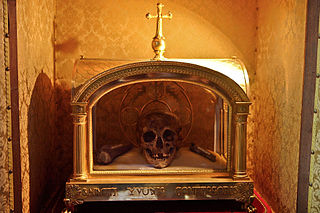
In religion, a relic is an object or article of religious significance from the past. It usually consists of the physical remains or personal effects of a saint or other person preserved for the purpose of veneration as a tangible memorial. Relics are an important aspect of some forms of Buddhism, Christianity, Islam, shamanism, and many other religions. Relic derives from the Latin reliquiae, meaning "remains", and a form of the Latin verb relinquere, to "leave behind, or abandon". A reliquary is a shrine that houses one or more religious relics.
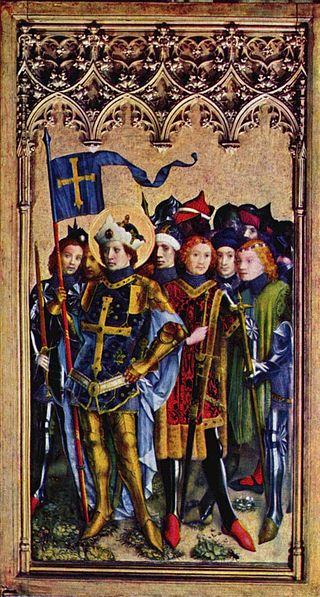
The Theban Legion figures in Christian hagiography as a Roman legion from Egypt —"six thousand six hundred and sixty-six men" — consisting of Christian soldiers who were martyred together in 286, according to the hagiographies of Maurice, the chief among the Legion's saints. Their feast day is held on September 22.

September 21 - Eastern Orthodox liturgical calendar - September 23
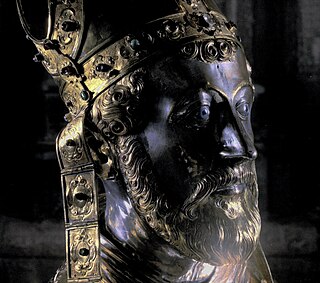
Saint Servatius was bishop of Tongeren. Servatius is patron saint of the city of Maastricht and the towns of Schijndel and Grimbergen. He is one of the Ice Saints. His feast day is May 13.

Alena, also known as Alène or Alina, is a Christian saint who was martyred around the year 640. She is sometimes referred to as Alena of Forest, Alena of Brussels, or Alena of Belgium, having died in Forest, Belgium, which is now one of the nineteen municipalities of Brussels.
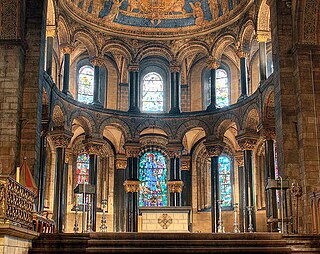
Mosan art is a regional style of art from the valley of the Meuse in present-day Belgium, the Netherlands, and Germany. Although in a broader sense the term applies to art from this region from all periods, it generally refers to Romanesque art, with Mosan Romanesque architecture, stone carving, metalwork, enamelling and manuscript illumination reaching a high level of development during the 11th, 12th and 13th centuries.

Felix and Regula are Coptic Orthodox and Roman Catholic saints. They are the patron saints of Zürich.

Euphemia, known as Euphemia the All-praised in the Eastern Orthodox Church, was a virgin martyr, who died for her faith at Chalcedon in 303 AD.

The Basilica of Saint Servatius is a Roman Catholic church dedicated to Saint Servatius, in the center of Maastricht, Netherlands. The architecturally hybrid but mainly Romanesque church is situated next to the Gothic Church of Saint John, backing onto the town's main square, Vrijthof.
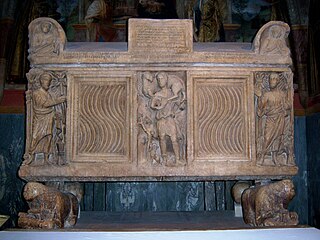
Saint Catervus is the patron saint of Tolentino. Catervus is said to have brought the Christian faith to the city. Tolentino is known to have had bishops by the fifth century.

Maurice was an Egyptian military leader who headed the legendary Theban Legion of Rome in the 3rd century, and is one of the favourite and most widely venerated saints of that martyred group. He is the patron saint of several professions, locales, and kingdoms.
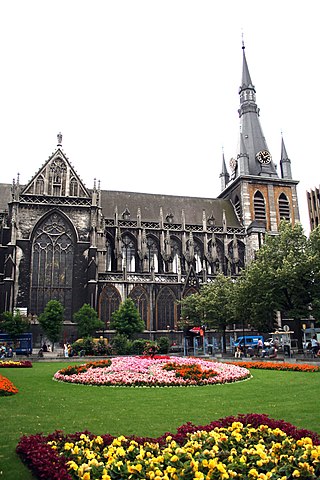
The Diocese of Liège is a Latin Church ecclesiastical territory or diocese of the Catholic Church in Belgium. The diocese was erected in the 4th century and presently covers the same territory as Belgium's Liège Province, but it was historically much larger. Currently, the diocese is a suffragan in the ecclesiastical province of the Archdiocese of Mechelen-Brussels. Its cathedra is found within St. Paul's Cathedral in the episcopal see of Liège.
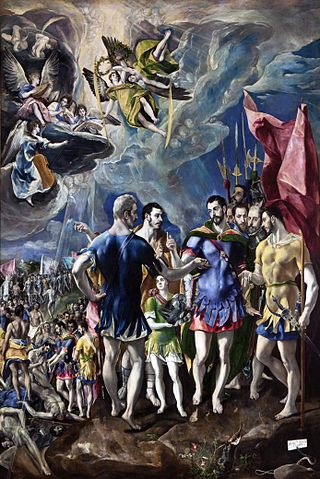
Exuperius or Exupernis is venerated as a saint and martyr by the Catholic Church; according to tradition, he was the standard-bearer of the Theban Legion and thus a companion to Saint Maurice.

Saint Antoninus of Pamiers was an early Christian missionary and martyr, called the "Apostle of the Rouergue". His life is dated to the first, second, fourth, and fifth century by various sources since he is often confused with various other venerated Antonini. Today he is revered as the patron saint of Pamiers, Palencia, and Medina del Campo. His historicity and exact identity are in doubt.

Saint Eleutherius of Tournai is venerated as a saint and considered the first bishop of Tournai. The Catholic Encyclopedia writes that "historically there is very little known about St. Eleutherius, but he was without doubt the first Bishop of Tournai."

Magnus of Cuneo is venerated as a martyr and member of the legendary Theban Legion. The center of his cult is situated at the mountain sanctuary known as the Santuario di San Magno, in the Valle Grana, Castelmagno, in the province of Cuneo. His feast day is August 19.

Bessus, sometimes Besse, is venerated as a member of the legendary Theban Legion, whose members were led by Maurice and were martyred for their Christian faith in the 3rd century.

The Treasury of the Basilica of Saint Servatius is a museum of religious art and artifacts inside the Basilica of Saint Servatius in Maastricht, Netherlands.

Verena of Zurzach, also known as Saint Verena, was an early Christian consecrated virgin and hermit. She is venerated as a saint in the Eastern Orthodox Church, Roman Catholic Church and Oriental Orthodox Churches. She is especially venerated in Switzerland, where her cult is attested in Bad Zurzach, the reported place of her burial, from at least the 5th century. Her feast is on 1 September.

The Pilgrimage of the Relics or Maastricht Septennial Pilgrimage is a seven-yearly Catholic event in the Dutch city of Maastricht. Originating in the Middle Ages, it developed from a pilgrimage to the grave of Saint Servatius into the present-day religious, historical, cultural and commercial enterprise. Highlights in the programme are the displaying or unveiling of the relics in the main churches and secondly, the processions with the town's main relics. The next pilgrimage will take place in 2025.
























